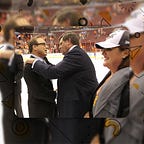Frozen Excellence: A Holistic Guide to Elite Hockey Training
With its speed, precision, and strategic finesse, hockey demands a unique blend of athleticism. Aspiring to play at the elite level requires a holistic training approach beyond conventional workouts. In this comprehensive guide, we unveil the intricacies of elite hockey training — providing insights into the multifaceted regimen that separates the extraordinary from the ordinary.
Power Dynamics Elevate Your Strength Game
Elite hockey players are a powerhouse of strength, seamlessly combining power and precision. Building a robust foundation starts with incorporating compound strength exercises. Squats, deadlifts, and bench presses form the cornerstone of strength training, engaging multiple muscle groups.
To enhance explosive power, introduce plyometric exercises into your routine. Box jumps, medicine ball throws, and jump squats mimic the dynamic movements of the game, fortifying your ability to accelerate, change direction, and unleash powerful shots on the ice.
Cardiovascular Mastery: The Engine of Your Performance
The cardiovascular demands of hockey necessitate a nuanced approach to training. Blend high-intensity interval training (HIIT) with sustained cardiovascular exercises. Sprint intervals, shuttle runs, and cycling in bursts mirror the stop-and-start nature of the game, preparing your body for the rigorous demands on the ice.
Longer, moderate-intensity cardio sessions, such as running or rowing, contribute to a well-rounded cardiovascular foundation. This dual approach ensures you not only have the explosive bursts needed during the game but also the stamina to endure its entirety.
Agility and Precision Navigating the Ice with Finesse
Hockey’s essence lies in swift, precise movements, and agility is the key. Incorporate agility drills focusing on lateral movement, quick changes of direction, and footwork. Cone drills, ladder exercises, and shuttle runs enhance your agility, allowing you to outmaneuver opponents gracefully.
Refine your reaction time with reactive agility drills. Quick pivots, crossovers, and intricate footwork drills on the ice simulate the real-time demands of the game, fostering precision in every stride and maneuver.
Skill-Specific Training Mastering the Craft
Beyond raw athleticism, elite hockey players are masters of their craft. Dedicate specific sessions to skill training, focusing on stickhandling, shooting accuracy, and puck control. Invest in a shooting pad for off-ice drills, honing your skills beyond the rink.
Game-specific drills, such as receiving passes, executing dekes, and perfecting various shots, should be integral to your training. These sessions enhance your skills and cultivate mastery that sets you apart during crucial moments in a game.
Flexibility and Joint Health Navigating the Frozen Terrain
Flexibility is often an unsung hero in elite hockey training. Engage in dynamic stretching pre-workout to enhance joint mobility and prepare your body for the intensity of training. Post-workout, adopt static stretches to improve overall flexibility and aid muscle recovery.
Incorporate yoga or Pilates into your routine, fostering flexibility, balance, and body awareness. These practices contribute to injury prevention and improve your fluidity on the ice — a critical factor in maintaining peak performance.
Balance and Core Stability The Foundation of Precision
Balancing on ice demands exceptional stability and core strength. Integrate exercises challenging your balance — single-leg squats, stability ball exercises, and balance board drills. These activities fortify your equilibrium and contribute to overall core strength.
Prioritize core stability exercises — planks, Russian twists, and anti-rotation drills. A strong core improves your balance and enhances shot power, body control, and overall stability during intense gameplay.
Strategic Recovery Protocols The Silent Architect of Success
Elite hockey players understand that recovery is as crucial as training. Prioritize adequate rest, emphasizing quality sleep to facilitate effective muscle repair and rejuvenation.
Post-workout, ensure your nutrition supports recovery, with a focus on protein intake. Employ recovery tools like foam rollers, massage therapy, and stretching to alleviate muscle tightness and enhance flexibility. Cold and hot therapy — ice baths, contrast showers — accelerate recovery, ensuring you stay primed for optimal performance.
Mental Mastery: The Secret Weapon of Elite Athletes
Precision on the ice extends beyond physical prowess; it encompasses mental fortitude and strategic insight. Embrace mental conditioning exercises, including visualization, mindfulness, and focus drills. Visualization of successful plays and positive outcomes contributes to mental resilience and performance consistency.
Simulate high-pressure game scenarios in your mind, envisioning successful plays and calmly navigating challenges. A solid mental game ensures you approach every game with focus, composure, and the confidence to make split-second decisions.
Crafting Your Symphony of Excellence
Training for elite hockey is an art — a symphony that harmonizes strength, agility, skill mastery, and mental resilience. By embracing a holistic approach to training, you can elevate your game to new heights and position yourself among the elite.
Consistency is your ally. The cumulative effect of disciplined, multifaceted training sets you apart on the ice. Whether you’re a seasoned player or entering the world of elite hockey for the first time, this guide equips you with the tools to craft your symphony of excellence.
So, lace up your skates, immerse yourself in the challenge, and embark on the journey of elite hockey training. The ice awaits — a canvas for you to paint the strokes of your precision, power, and prowess. In hockey, where frozen excellence reigns supreme, your symphony is yours to compose, and the spotlight on the ice is yours to claim.
